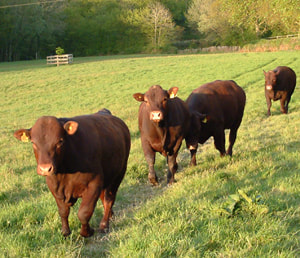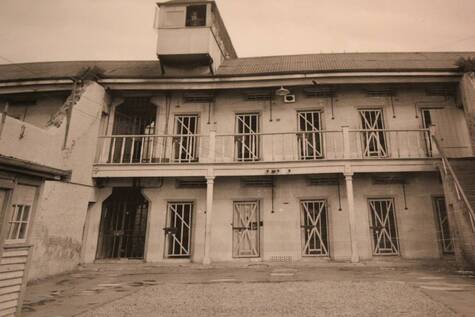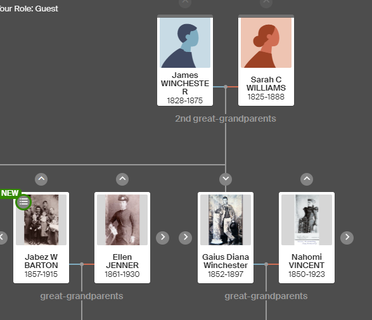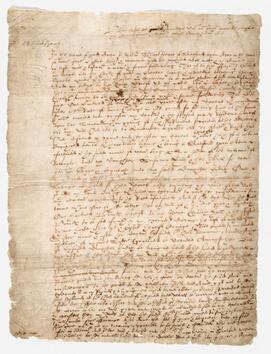|
#52Ancestors theme for this week is Document and I have so many copies of documents that I was struggling to pick one to write about. Searching my A3 folder of early photocopies from TNA I found a large envelope which contained a photocopy of the Farm Survey for my great grandfather George Charles Pilbeam’s farm at Three Cups near Punnetts Town. Wow I had forgotten I had ordered it! The envelope is postmarked 2013. When the Second World War began in September 1939, Britain was faced with an urgent need to increase food production, as imports of food and fertilisers were drastically cut. The area of land under cultivation had to be increased significantly and quickly. The Ministry of Agriculture and Fisheries set up War Agricultural Executive Committees in each county (‘County War Ags’) to carry out a farm survey between 1940 and 1941 and to use the information collected to bring uncultivated land under the plough and to improve poor farms. Once the short-term objective of increasing food production had been met, the government decided to carry out a more general National Farm Survey between 1941 and 1943, with a longer-term purpose of providing data that would form the basis of post-war planning. Such a survey was seen at the time as a ‘Second Domesday Book’, a ‘permanent and comprehensive record of the conditions on the farms of England and Wales’. The first survey showed that: No fruits or vegetables were being grown for human consumption. There was ¼ acre of main crop potatoes, ½ acre of turnips and swede for fodder. There was ¼ acre of kale for fodder. Also ¼ acre of All other crops. Seven acres of permanent grass for mowing and 11 ¾ acres of permanent grass for grazing. Total acreage was 20 acres. Employed labour on 4 June 1941 consisted of 1 male part time worker, 21 years old and above. There were 8 cows and heifers and 17 fowl over 6 months and 1 horse used for agricultural purposes. The general survey for Rushford Farm was carried out on 30 October 1942. The farm was recorded as 18 acres within the parish of Warbleton and the farmer was G C Pilbeam of Rushford Farm, Three Cups, Dallington, Heathfield, Sussex.
The general comments are as follows:- Small dairy holding quite well kept and having sufficient ploughed out to maintain the herd in winter green fodder. One field has also been reseeded. This could be carried further to some of the other fields where the grass is getting worn out. Stock and general management satisfactory. The water arrangements could be better. Stock: Cows 7 young stock 4 Horses 1. Information gained from the survey tells me that: George Pilbeam owned the farm and was a full time farmer. He didn’t occupy any other land or have other grazing rights. The condition of the farm was 100% medium soil. The farm was conveniently laid out and was 100% naturally fair. The situation with regard to road was fair and railway was bad. The nearest railway station is Heathfield some miles away. The condition of the farmhouse was good, farm buildings and road were fair, fences – good, ditches – fair and field drainage was good. There were no infestations and no derelict fields. Water supply to the farmhouse was from the well, farm buildings from the roof, fields from a stream and there was a pond that supplied water both to the farm buildings and the fields. There was no seasonal shortage of water and no electricity supply. The farm was classified as A. The condition of the Arable land was good, pasture good to fair. Adequate use of fertilisers on the arable land and to some extent on the grassland. For the 1941 harvest 2 fields were marked for fodder crops to be grown. The first glance at the documents didn’t look like it was going to reveal as much information as it did. The condition of the farm and buildings as well as the stock on the farm. A lot of information about the farm can be gleaned from it and I’m off to see if there are any other farms in my family I need to know more about.
0 Comments
Richard Message married my great x4 Grandmother Hannah Oliver in Dallington, Sussex on 20 October 1803. They had one child from the marriage, Richard baptised on 9 February 1807 at Warbleton, Sussex where the family were living. Various contacts have mentioned a second child, Philadelphia who lived between 1804 and 1817 but have never shown me any proof and I have searched high and low with no sign. So I discount until someone shows me the evidence! Hannah had two children already by a previous relationship with a Benjamin Carley, Benjamin Oliver Carley baptised on 16 February 1800 at Warbleton, and Stephen Carley Oliver born in 1802 in Warbleton. Richard may have been born in Shoreditch around 1786, a baptism has been found on 31 January 1786 to a Richard and Mary Message of Holywell and there is nothing in Sussex at that time. But Richard’s story can be picked up in 1806 and fits this week’s theme of Negatives for #52Ancestors nicely. Richard appeared in the England and Wales Criminal Register 1791-1892 on Ancestry.co.uk charged with Felony (which was a serious crime) at the January session, he was acquitted. Then he turned up again in 1807 on the England and Wales Criminal Register 1791-1892 on Ancestry.co.uk at the Lent session at Horsham Court charged with Larceny (theft of personal property), the sentence was 14 years Transportation. At the age of 21 in 1807 he appeared on the register of Perseus a Prison Hulk register, convicted on 16 March at Horsham of Felony which is a bit confusing unless it was a separate charge from the Criminal Register above. He was awaiting transport on the Admiral Gambier. The Perseus was moored in Portsmouth Harbour and it would appear from the next record that they were moored for over a year. It must have been grim! A newspaper report from the Sydney Gazette and New South Wales Advertiser, Sunday 25 December 1808 reported that the Admiral Gambier arrived from England under Captain Harrison with 197 male prisoners. They sailed from England on the 2nd July and arrived in late December so a 5 month voyage, but all were reported in good health and good spirits. A small handful died on the passage.
Richard appeared on a list in 1811 as being in Hobart town in Tasmania and then in 1816 he appeared in the New South Wales Convict Register of Conditional and Absolute Pardons with an Absolute Pardon. Amazingly the next record found for Richard is the record of his marriage on 26 June 1816 to Mary Ann Mullins in Hobart, Tasmania. She was a free person. Unfortunately Richard doesn’t appear to have been free to marry again, as he was still married to Hannah although she was all those miles away in England. I guess the likelihood of him ever returning to England was so very slim, he took his chances as many others must have too. He was 31 years old and Mary Ann was 19 years old. Richard died on 5 October 1821 in Hobart, Tasmania aged 35 years, having never returned to England. Notes: Willetts, J (n.d.) "Convict Ship Admiral Gambier 1808" Free Settler or Felon https://freesettlerorfelon.com/convict_ship_admiral_gambier_1808.htm 18 April 2022 – more information about the Admiral Gambier How do you spell that? is the theme for this week’s #52 Ancestors. I’m sure we all have stories from our family trees of misspelt names. I have one family for instance that somewhere in the middle of the 19th century became Rusbridge from Risbridger. All the early records are Risbridger and then suddenly records start showing Rusbridge. When I work backwards suddenly I could no longer find any Rusbridges but when I found the first Risbridger I was then able to start finding other missing family members and fit them together. I presume somewhere along the line someone writing down what they heard misheard an accent and it simply changed. Two generations have a mixture of the two. But my best family for misspelt names is that of James Traies, my Great x 5 grandfather who was born in Exeter in Devon in 1785 to Samuel and Jane. At some point James travelled to London where he spent the rest of his life, living around the Kensington area. James was a Tin Plate worker. He married 5 times, although is first marriage to Hannah has not been found, just her death, and Ann who he married next was thought to be the same woman but can’t be, he married her after his first children were born. The search carries on for the first marriage in the early part of the 19th century. Searching for the records for this family was a slow and laborious task and some records remain hidden to this day. Not only can parts of the family be found under; Trayes, Treays, Treayes, Traces and Trease to name a few but there were other mistranscriptions such as the 1851 census for James which took ages to find. It was eventually found under Fraies. I notice on Ancestry.co.uk that a user submitted a correction to this record in 2020 which is curious because I submitted a correction in about 2007. Ancestry obviously didn’t believe me! The 1861 census was found under Truies and other records were found under names such as Praies.
Searching for James and his son Samuel and in turn his daughter Emma who married James Turner, all part of my direct line taught me quite early on that it helps to be a little creative when searching for missing records. Sometimes you need to think outside the box and be clever with your searching. One day I might succeed in finding out who Hannah (first wife) was. For this week’s #52Ancestors I’m having a rant. No not really, just a little bug bear of mine. The theme is ‘Check it out’ which instantly reminds me of something I learnt fairly early on in my genealogy journey. If at all possible you should find 3 primary sources to prove a person is the correct one. Of course, this is not always possible but so often when searching for someone on a certain subscription site and I find that person appearing on a tree something doesn’t quite fit and there are never any sources cited to show where they got the information from. Sound familiar? For instance, when I started researching my tree some 20 years ago, I was sent a copy of a tree from someone, and they had my Great x3 Grandfather James Winchester who married Catherine Sarah Williams in 1850 in Ashburnham. This is correct, we have more than one primary source that proves this information. Marriage certificate, and at least two census records as well as birth certificates for some of the children. I merrily copied what they had on the tree with an incorrect date of birth of 1830 in Ashburnham and his parents were William and Philadelphia, with several generations going back. I can’t remember the exact details now, but something didn’t quite fit. The census records I have for him are; 1841 – born 1828, 1851 – 1821 and 1871 – 1828. It was when I found the 1841 census that alarm bells started ringing, James was age 13 with a Thomas Winchester age 50, so presumably his father, not a William. I eventually checked it out and now have him, son of Thomas Sinden Winchester and Ann Stonestreet. My theory about the 1851 census is that his wife was older than him but he was embarrassed, he was only 23 and so he said he was 30 to appear older than his wife who was 26. Of course, without finding Catherine’s birth I can’t prove that at all but it’s a fun theory. There are many instances on that same website where someone for instance, was searching for Joe Bloggs born about 1850 in Sussex and they find one Joe Bloggs born 1845 in Hertfordshire, think that will do and fit him into the tree. But without checking at least other parish records such as burials they cannot see the glaringly obvious for anyone who carries on searching other records, that particular Joe Bloggs died in 1848 so cannot be the right one.
Also there are many other less obvious records that can be searched that give clues such as wills which often name all children and can be checked with parish records, newspapers sometimes can be a really useful source of information about families, funerals and weddings name relatives in attendance and help to widen the family picture. One of the simplest ways of proving you have a correct family, after 1837 is to purchase the birth certificates for siblings and check the mother’s maiden name tallies for all of them. These days you don’t even have to purchase the certificates, you can tally the maiden name on the GRO website simply by searching. |
AuthorKerry Baldwin Archives
June 2023
Categories |
|
Copyright Kerry Baldwin 2024
|
Proudly powered by Weebly
|











 RSS Feed
RSS Feed
